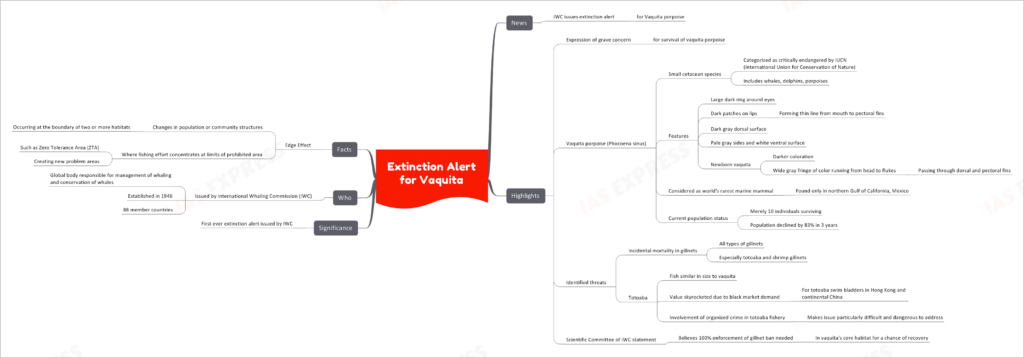Extinction Alert for Vaquita

The International Whaling Commission (IWC) has issued an extinction alert for the vaquita porpoise (Phocoena sinus), expressing grave concern for its survival. The vaquita, a small cetacean species, has been categorized as critically endangered by the International Union for Conservation of Nature (IUCN). With a current population of merely 10 individuals, the vaquita faces numerous threats, and urgent action is needed to prevent its extinction.
Vaquita: A Critically Endangered Species
The vaquita porpoise is a unique cetacean species that includes whales, dolphins, and porpoises. It is distinguishable by its large dark ring around the eyes, dark patches on the lips forming a thin line from the mouth to the pectoral fins, and a dark gray dorsal surface. The sides are pale gray, and the ventral surface is white. Newborn vaquitas have a darker coloration with a wide gray fringe of color running from head to flukes, passing through the dorsal and pectoral fins. This distinctive appearance makes them easy to recognize.
The vaquita is considered the world’s rarest marine mammal and is found exclusively in the northern Gulf of California, Mexico. Unfortunately, the current population status is dire, with only 10 individuals surviving. Over the past three years, the vaquita population has declined by a staggering 83%, indicating a rapid decrease in numbers.
Identified Threats to the Vaquita
The main threat to the vaquita’s survival is incidental mortality in gillnets. These nets, used for fishing, pose a significant risk to the vaquitas, as they get entangled and drown. The vaquitas are particularly vulnerable to all types of gillnets, especially those used for catching totoaba and shrimp. The totoaba fish is similar in size to the vaquita and is in high demand due to its swim bladders being sold on the black market in Hong Kong and continental China. Organized crime involvement in the totoaba fishery makes addressing the issue even more challenging and dangerous.
IWC’s Statement and Recommendations
The Scientific Committee of the IWC has issued a statement highlighting the urgent need for 100% enforcement of the gillnet ban in the vaquita’s core habitat. Without stringent enforcement, the vaquita has little chance of recovery, and the population will continue to decline rapidly.
Significance of the Extinction Alert
The issuance of an extinction alert by the IWC for the vaquita is a significant event. It marks the first time such an alert has been issued by the global body responsible for the management of whaling and the conservation of whales. This highlights the severity of the vaquita’s situation and underscores the need for immediate and decisive action.
The Role of the International Whaling Commission
The International Whaling Commission (IWC) is a global body established in 1946 with the responsibility of managing whaling practices and conserving whale populations worldwide. It consists of 88 member countries that collaborate to protect marine mammals and their habitats.
The Edge Effect and Its Impact
The edge effect is a phenomenon where changes in population or community structures occur at the boundary of two or more habitats. In the case of the vaquita, fishing efforts concentrate at the limits of prohibited areas, such as the Zero Tolerance Area (ZTA), creating new problem areas. This exacerbates the threats faced by the vaquita population and makes conservation efforts even more complex.
If you like this post, please share your feedback in the comments section below so that we will upload more posts like this.

